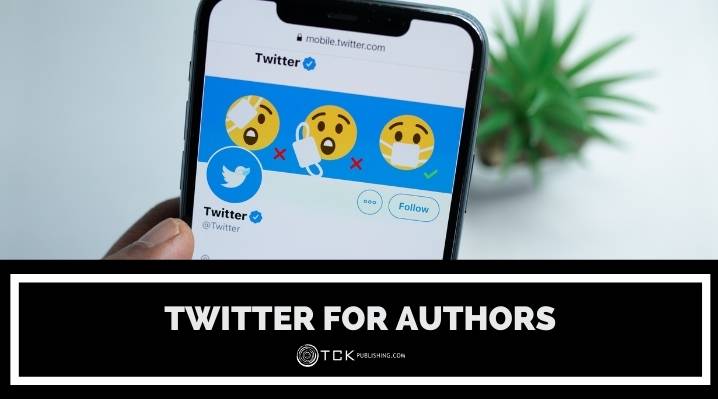
Social media is one of the easiest and most convenient ways to grow an online presence. For authors, it can be the difference between successfully launching a book or leaving it to stagnate.
Twitter is one of the most popular social media platforms currently in existence. As of the first quarter of 2021, it had more than 200 million daily active users. That’s a lot of people you can potentially market to. In this article, we’ll take a look at how you can use Twitter to develop your brand.
Twitter Tips for Writers
Social media can be confusing; navigating all the information and opinions that are flying around in different formats takes a bit of getting used to. Most people go with a trial-and-error strategy to become familiar with these platforms.
To help you over some of those learning hurdles, here are a few tips you can follow to jumpstart your Twitter journey. They’ll get you familiarized with Twitter’s interface and teach you a few tricks so you can start making the most of your tweets sooner.
1. Think of an appropriate username.
Your username will be your identity in the Twitterverse. Some authors choose to use only one account for their personal and professional content, while others prefer separating the two.
Depending on which you prefer, you should choose a username that embodies your personality, your brand, or both. Make sure that it’s unique and instantly memorable. Don’t make it complicated, as users will find it harder to remember.
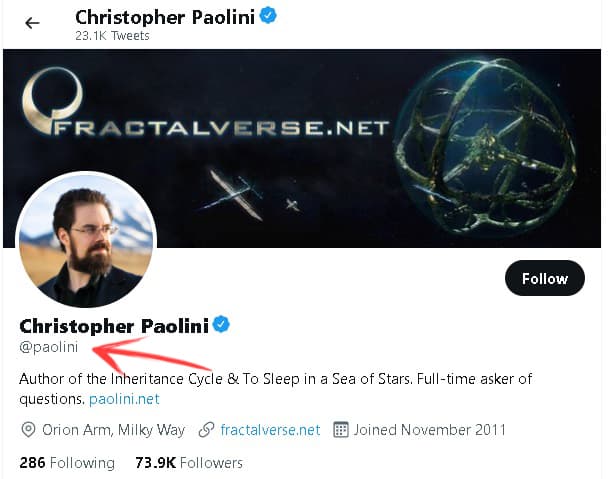
Some writers even simply use their names. Take Christopher Paolini as an example. His Twitter username is just his surname. It’s short, memorable, and unique enough to identify him as the famous writer. But while this route is more advantageous for established writers, there’s no rule stopping you from doing it as a newbie.
Remember: It’s okay if you don’t have the perfect username yet. You can always change it later on!
2. Optimize your profile.
One of the most common mistakes people make with Twitter is leaving their account barren. Not only does this make your account look sloppily made, but people might even think that it’s a spam account.
When creating your Twitter account, make sure that you:
- Add a suitable profile picture. If you plan on using a real photo of yours, ensure that you’re easily identifiable in the photo. Generally, this means having your face is clearly visible with no distracting elements in the background or foreground. Also, avoid having multiple people in the picture so that no one is confused about who you are. If you prefer using an author logo, go for it.
- Include a short bio. Consider this your introduction to possible followers. Make it count by explaining to them who you are, what you do, and why they should follow you. Inject a bit of personality by using wordplay or anything that’s you.
- Include a link to your website, other social media accounts, or any other relevant links. This will make it easier for your followers to find you on other platforms.
- Add a header photo. When people look at your account, the header photo is one of the first things they’ll notice because of its size. Take advantage of that by using a photo that represents you or your works. The cover of your most recent work perhaps, or maybe a personal photo that shows your interest in your chosen genre.
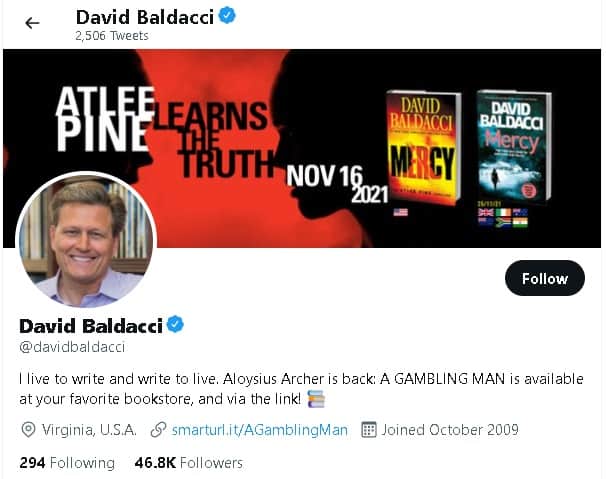
Take a look at David Baldacci’s Twitter account. His face is clearly seen in his profile picture. His bio introduces him perfectly as a writer and includes a short promotion for his latest work complete with a link. His header image also promotes another of his latest books.
You’ll need to update these once in a while too. Apart from your posts, making changes to your account shows that you’re active. Plus, it’s a good strategy to change these elements (especially your bio) to announce news about you, current promotions, etc.
3. Use a combination of media.
While Twitter is primarily text-based, you are also able to post images, videos, and audio. Take advantage of this by using different types of tweets (what your posts on Twitter are called).
Using a variety of media means you’re engaging your audience through different senses. A video or audio tweet provides greater satisfaction to them than simply reading a short tweet because you’re also affecting their auditory senses rather than just the visual. This also brightens up your feed compared to just using plain text.
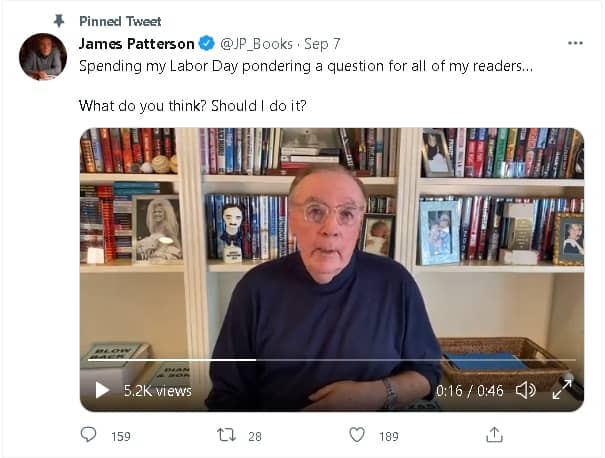
If you check out James Patterson’s Twitter account, he likes to post short videos of him discussing a certain topic. This is aside from the tweets, retweets, and photos he also posts. It’s a great example of varied content on Twitter.
Also, keep in mind that a tweet is limited to only 280 characters, so make your words count.
4. Go easy on the self-promotion.
Have you ever entered a store to browse some products and a salesperson kept hounding you to buy something? That’s what it feels like when a person visits your profile and all they see is self-promotion.
While promoting your work isn’t bad (and your followers do understand that you’d like your works to be a success), there is always a point where it becomes annoying. People simply can’t engage very well with content that’s always about “buy my book” or “read this review about my book.”
In short, don’t hard sell. There are less obvious and more effective ways to promote your work without sounding like you’re after your followers’ money. Show them snippets of your writing process, or offer excerpts of your most recent work. Retweet reactions from your fans. Doing it this way tells your followers that you’re on the platform to share experiences with them, not just to sell.
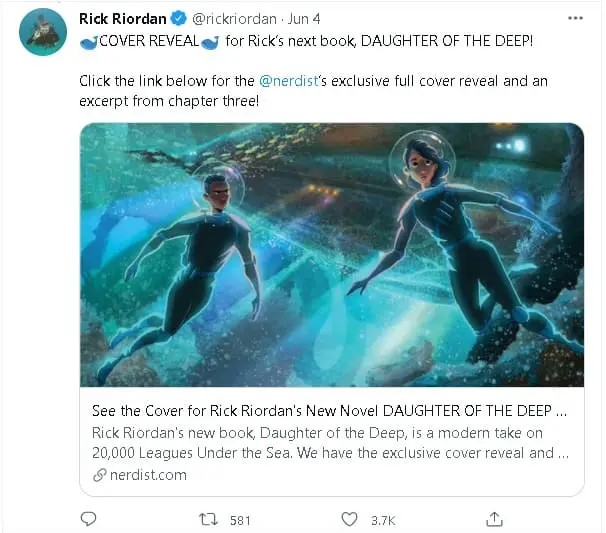
The above image is a good example of giving your audience value without hard selling. Rick Riordan is giving his fans a glimpse of his newest book through cover art and excerpts rather than asking them to buy it when it’s already out. He’s letting them make the decision on their own.
5. Connect with the relevant ecosystem.
When I say ecosystem, I’m talking about the people, industries, and interests that share the same space. As a writer, it makes sense to engage with other writers, genre enthusiasts, publishers, etc. This way, you’re surrounded by content that’s relevant to you.
And it’s not exclusively just about writing—there are a lot of overlapping niches that you can plumb for information. For example, graphic artists and illustrators are good ways to get inspiration for your book’s cover art or your logo.
To connect to the relevant ecosystem:
- Search keywords you’re interested in. Start off with general ones (writing, books, authors, etc.), then progressively get to more specific keywords (detective fiction, anti-heroes, magical realism).
- Look for your personal interests. Search for your favorite authors, genres, and other topics and check out what activities surround them. You’ll likely discover news and events that interest you.
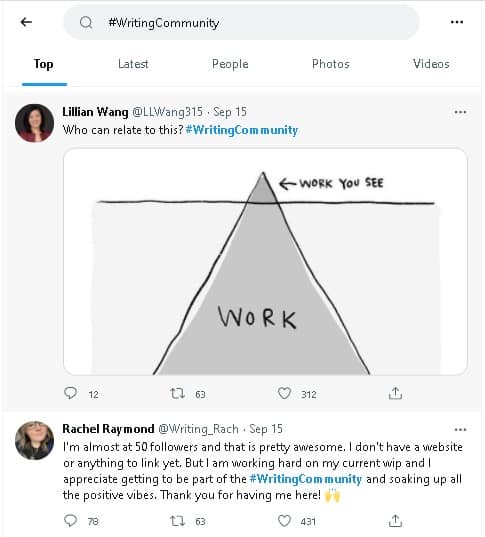
- Use hashtags. These are words and phrases preceded by the hash sign (#) that social media platforms use to categorize content. For example, searching for “#WritingCommunity” will show you posts that have used this hashtag, which are all likely to be about the writing community. Including hashtags on your posts also makes it easier for other users to find you. Don’t go overboard, though: one to two hashtags per post is more than enough.
6. Remember you are more than your book.
When people become interested in your work, it’s inevitable that they’ll be curious about you too. They want to know more about the person behind the book that they like.
Hundreds of thousands of people know J.K. Rowling, Neil Gaiman, and Paul Coelho as excellent writers. But if you check out their Twitter accounts, their tweets are not just about their books. They share their opinions and interests, crack jokes, and show fans that they’re human just like them.
Twitter, while being a great place to market or advertise, is still a platform for making connections. Take the opportunity to show your followers who you are as a person and as a writer. Don’t be afraid to share opinions that some followers may not like. Because if you act as a human, there’s a greater chance for a deeper connection between you and your followers. It’s why a lot of big companies humanize their brand.
Here are a few post ideas to start you off:
- Books, movies, and TV series you’re currently reading/watching
- A behind-the-scenes look at your writing process
- Your interests and hobbies aside from writing
- Reviews of books you love
- Polls asking followers for their opinions (there’s an option to make a poll when you make a new tweet)
- Personal stories and experiences

Look at this couple of posts that Ian Rankin shared. It’s not about books but simple posts of what he’s doing when he’s not writing. It gives his fans a glimpse of the person behind the stories he tells.
7. Interact with people
Don’t be a post-and-run type of user. Take the time to react to, retweet, and comment on posts. It doesn’t even have to be yours. See a post you like? Feel free to engage.
By interacting with other users, you’re solidifying your place in the Twitterverse. People will begin to follow you, remember you, and actively search you out. You’ll become a familiar and welcomed member of the community.

Try to respond to your followers too. It may become time-consuming and impossible to talk with everyone as your following grows, but replying to some of them goes a long way. Your responses make followers feel valued, and they’ll support you even more.
Take a look at the above photo. Though Neil Gaiman’s replies are simple, it shows that he takes the time to read comments. He’s well-known for being active on social media, even going as far as doing entire discussions through comment threads.
Is Twitter Good for Authors?
As one of the most popular social media platforms, Twitter is a great platform for writers. Apart from having more than 200 million active daily users, over 500 million tweets get sent per day. That’s an extremely high volume of engagement.
It’s also a place where you can rapidly extend your audience reach. When you gain a following, it can mean a higher number of sales and readers for your works. Your visibility as a writer can skyrocket, opening up new avenues for you to explore.
It will still take time and effort, of course. Engaging with your audience can be difficult, but the pay-off is well worth the effort. Things can be hectic and stressful at first, but once you gain momentum, you’ll likely move at a consistent pace.
Do you use Twitter to grow your audience? Share your experience in the comments below!
If you enjoyed this post, then you might also like:
- Instagram for Writers: Tips for Developing Your Social Media Presence
- How To Build Brand Loyalty – Hint: Your Consumers Are the Only People Who Matter
- How an Author Logo Can Help Your Brand
- 14 Color Palette Generators for Your Eye-Catching Brand

Cole is a blog writer and aspiring novelist. He has a degree in Communications and is an advocate of media and information literacy and responsible media practices. Aside from his interest in technology, crafts, and food, he’s also your typical science fiction and fantasy junkie, spending most of his free time reading through an ever-growing to-be-read list. It’s either that or procrastinating over actually writing his book. Wish him luck!

An amazing post with great tips as always. Anyone will find your post useful. Keep up the good work.
Thanks for reading! Glad you found it useful :)